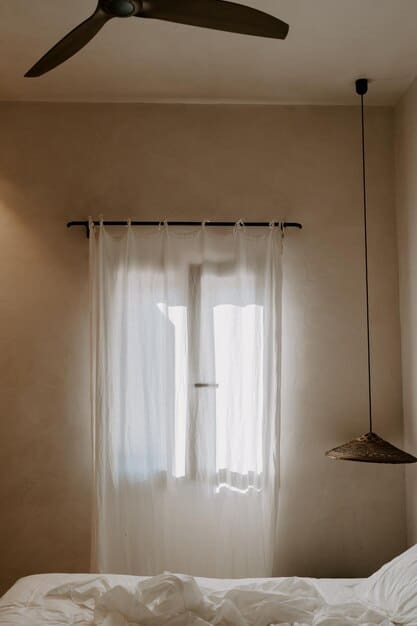Sleep Soundly: The Ultimate Guide to Room Temperature for Sleep

Achieving a full night’s sleep can often be simplified to one key element: maintaining the right room temperature. By understanding the ideal temperature range and how it affects your body’s natural sleep cycles, you can optimize your sleep environment for deeper and more restful sleep.
Do you often find yourself tossing and turning, unable to achieve a truly restful night’s sleep? While many factors contribute to sleep quality, one often-overlooked aspect is your bedroom’s temperature. Understanding and optimizing **insider knowledge: the secret to a full night’s sleep – the right room temperature** can be the key to unlocking deeper, more restorative sleep.
Why Room Temperature Matters for Sleep
Room temperature plays a significant role in regulating your body’s internal clock and facilitating the sleep process. When you sleep, your body naturally lowers its core temperature, signaling to your brain that it’s time to rest. The surrounding room temperature can either aid or hinder this process.
If the room is too warm, your body struggles to cool down, leading to restlessness and disturbed sleep. Conversely, if the room is too cold, your body expends energy to maintain its core temperature, which can also disrupt sleep.
The Science Behind Sleep Temperature
The body’s thermoregulation process is crucial for initiating and maintaining sleep. As you prepare for sleep, your body releases heat, and a cooler room environment helps facilitate this process. This is why a slightly cooler room is generally more conducive to sleep.
Studies have shown that the ideal temperature range for sleep is between 60 to 67 degrees Fahrenheit (15.5 to 19.4 degrees Celsius). This range optimizes the body’s ability to regulate temperature and promotes deeper sleep cycles.
- Melatonin Production: Lower temperatures can enhance the production of melatonin, a hormone that regulates sleep-wake cycles.
- Metabolic Rate: Sleeping in a cooler room may also slightly increase your metabolic rate, helping your body burn more calories during the night.
- Sleep Stages: Maintaining the right temperature supports the transition through different sleep stages, including deep sleep and REM sleep.
In conclusion, understanding the science behind sleep temperature is essential for creating an environment that supports optimal sleep. By maintaining the right temperature, you can enhance your body’s natural sleep mechanisms and improve your overall sleep quality.

Finding Your Ideal Sleep Temperature
While the generally recommended range is 60-67°F, individual preferences can vary. Factors such as age, clothing, bedding, and personal metabolism can all influence your ideal sleep temperature. Experimentation is key to finding what works best for you.
Start by setting your thermostat within the recommended range and observing how you feel. If you wake up feeling too hot or too cold, adjust the temperature accordingly, one degree at a time, until you find your sweet spot.
Factors Influencing Temperature Preference
Several factors beyond personal preference can impact your ideal sleep temperature. It’s important to consider these elements when optimizing your sleep environment.
For instance, babies and young children often require slightly warmer room temperatures than adults, while older adults may prefer slightly cooler temperatures due to changes in their body’s thermoregulation.
- Age: Infants and elderly individuals may require different temperature settings.
- Clothing and Bedding: The type of pajamas you wear and the thickness of your blankets can significantly affect how warm or cool you feel.
- Metabolism: Individuals with faster metabolisms may generate more heat, requiring a cooler room.
Ultimately, finding your ideal sleep temperature involves mindful experimentation and consideration of personal factors. By fine-tuning your environment, you can create the perfect setting for restful and restorative sleep, leading to improved overall well-being.
The Consequences of Sleeping Too Hot or Too Cold
Sleeping in a room that is either too hot or too cold can have significant impacts on your sleep quality and overall health. Understanding these consequences can further motivate you to optimize your sleep environment.
When the room is too warm, you may experience increased restlessness, frequent awakenings, and difficulty falling back asleep. This can lead to fragmented sleep patterns that disrupt crucial sleep stages.
Negative Impacts of Extreme Temperatures
Both excessively warm and cold temperatures can significantly affect sleep architecture and health.
Sleeping in a room that’s too cold can cause your body to shiver, disrupting necessary sleep cycles that assist with rest and recovery. Moreover, very cold conditions might exacerbate certain health problems.
- Disrupted Sleep Cycles: Extreme temperatures can interfere with the natural progression of sleep stages, including deep sleep and REM sleep.
- Increased Stress: Poor sleep due to temperature issues can elevate stress hormones like cortisol.
- Reduced Cognitive Function: Chronic sleep deprivation affects cognitive performance.
In summary, the impacts of sleeping in an environment that’s too hot or too cold extend well beyond immediate comfort. Creating a balanced, well-regulated sleep environment is crucial for supporting both physical and mental health. By addressing temperature concerns, people can drastically improve sleep quality, thereby enhancing wellness and daily functionality.
Practical Tips for Regulating Room Temperature
Achieving the perfect room temperature for sleep doesn’t require expensive solutions. There are many practical and cost-effective methods to regulate the temperature in your bedroom.
Simple strategies such as opening windows, using fans, and adjusting your bedding can make a significant difference. Layering your bedding allows you to easily adjust your warmth level throughout the night.
Simple Strategies for Temperature Control
Controlling room temperature can be achieved using a variety of tools and methods to optimize sleep conditions.
Adjusting room temperature doesn’t require large investments; smaller changes can affect sleep quality significantly.
- Use Fans: Position fans to circulate air and cool down the room.
- Adjust Bedding: Use layered bedding for easy adjustments during the night.
- Open Windows: Allow fresh air to circulate if the outdoor temperature is conducive to sleep.
Ultimately, managing bedroom temperature to achieve optimal sleep requires a mixture of careful preparation and quick adjustment possibilities. By using these straightforward solutions, readers can drastically improve their sleep quality and wake up feeling rested.

The Role of Bedding and Clothing
Your choice of bedding and sleepwear significantly impacts how your body regulates temperature during sleep. Selecting the right materials can help wick away moisture, regulate heat, and keep you comfortable all night.
Natural fibers such as cotton, linen, and bamboo are excellent choices for bedding and sleepwear as they are breathable and help regulate body temperature. Avoid synthetic fabrics that can trap heat and moisture.
Material Matters
Understanding the properties of different bedding and clothing materials can greatly influence sleep comfort and temperature regulation.
Choosing breathable textiles ensures a cooler, drier sleep, which in turn improves sleep cycles and overall health.
- Natural Fibers: Opt for cotton, linen, or bamboo bedding and sleepwear for breathability.
- Avoid Synthetics: Steer clear of synthetic fabrics that trap heat and moisture.
- Layering: Wear breathable layers that you can adjust depending on temperature in the room.
To summarize, the choice of bedding and clothes directly influences the thermal environment you create for slumber. Improving these components assures a more soothing, restful night, which is essential for supporting both bodily and psychological health requirements.
Creating an Optimal Sleep Environment
Beyond temperature, other factors contribute to creating an optimal sleep environment. Darkness, quiet, and comfortable bedding are all essential elements for promoting restful sleep.
Invest in blackout curtains to block out light, use earplugs or a white noise machine to minimize noise, and ensure your mattress and pillows are comfortable and supportive. A consistent sleep schedule and relaxation techniques can also enhance your sleep quality.
Holistic Sleep Environment
Creating a holistic sleep environment involves addressing numerous aspects beyond simple temperature management. Consideration of darkness, peace, and comfort contributes significantly to a fulfilling night’s sleep.
To ensure optimum sleep, people must produce an environment that encourages rest, comfort, and low stimulation. An environment like this contributes to better well-being and the capacity to awaken revived and prepared for the day ahead.
- Darkness: Ensure the room is dark with blackout curtains or an eye mask.
- Quiet: Use earplugs or a white noise machine to block out noise.
- Comfortable Bedding: Ensure your mattress and pillows are supportive and comfortable.
In essence, constructing an optimum sleep environment comprises a range of elements that, when combined, drastically improve the quality and time of sleep. By addressing each the temperature and these important elements, people can guarantee a nighttime routine that encourages profound, restful, and rejuvenated sleep.
| Key Point | Brief Description |
|---|---|
| 🌡️ Ideal Temperature | 60-67°F (15.5-19.4°C) optimizes sleep quality. |
| 🛏️ Bedding Matters | Choose natural, breathable materials like cotton. |
| 🌙 Optimize Environment | Ensure darkness, quiet, and comfortable bedding. |
| 🔄 Adjust as Needed | Personalize temperature settings based on individual factors. |
FAQ
▼
The ideal room temperature falls in the range of 60 to 67 degrees Fahrenheit (15.5 to 19.4 degrees Celsius), but what works best for you might vary depending on individual factors like age and bedding.
▼
Room temperature impacts your body’s ability to regulate its core temperature, which is essential for initiating and maintaining sleep. A cooler environment supports deeper, more restful sleep cycles by promoting heat release.
▼
Sleeping in a room that is too warm can cause restlessness, frequent awakenings, and difficulty falling back asleep, which can disrupt crucial sleep stages and affect overall sleep quality.
▼
Bedding made from natural, breathable fibers like cotton, linen, or bamboo is ideal for regulating temperature. These materials help wick away moisture and allow for better airflow, keeping you comfortable all night.
▼
Yes, a variety of factors affect sleep quality. Creating an optimal sleep environment includes minimizing noise and light, ensuring comfortable bedding, keeping a consistent sleep schedule, and using meditation techniques.
Conclusion
Optimizing your room temperature is a simple yet powerful strategy to enhance your sleep quality. By understanding your body’s needs and implementing practical temperature regulation techniques, you can create a sleep environment that promotes restful and restorative sleep, leading to improved overall health and well-being.





